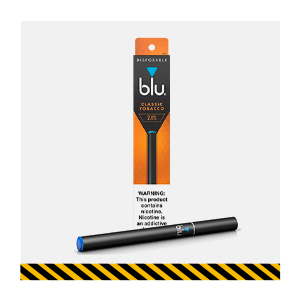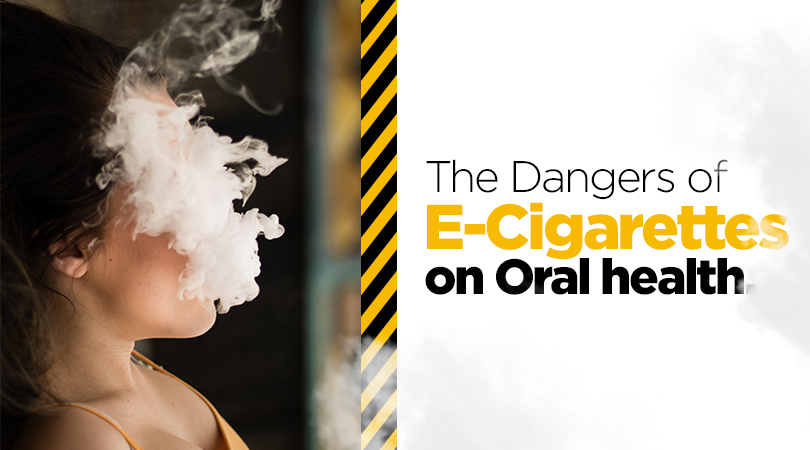It’s no secret that smoking and oral health do not mix, and fortunately cigarette smoking has been on a steady decline for decades. That being said, Electronic Cigarettes have seemingly taken the place of traditional smoking and have become the new norm.
Although the use of E-Cigarettes is typically viewed as less harmful by the public, the effects they have on oral health can be equally as dangerous as traditional cigarettes.
What are E-Cigarettes?
E-Cigarettes, commonly referred to as “vapes”, are electronic devices that heat a liquid that is in turn inhaled by the user, creating a cloud of vapor “smoke” that simulates the feeling of smoking. E-Cigarettes work by heating a liquid, referred to as “e-liquid” or “e-juice” that is typically made up of the ingredients propylene glycol, glycerine, water, nicotine, and various flavors. e-liquid can also be purchased without nicotine content, or alternatively with THC in states where marijuana can be legally purchased.
As opposed to the standard tobacco flavor of traditional cigarettes, most people who vape prefer to use e-liquids that come in a variety of different flavors, often fruity or candy-like. It is argued that these flavors make the product more attractive for children, young adults, and people who normally do not smoke tobacco cigarettes.

There are many reasons why people vape, including but not limited to:
- Quitting smoking
- Being able to smoke in public
- Recreation
- Believing it is a healthier alternative to cigarettes
What is Propylene Glycol and Vegetable Glycerin?
Propylene Glycol (PG) is a synthetic liquid that is commonly used by the food, chemical and pharmaceutical industries. It’s main purpose is absorbing water, which is used to maintain moisture levels in products like food, medicine and cosmetics. The Food and Drug Administration (FDA) has described PG as “generally recognized as safe”.
Vegetable Glycerin (VG), The second main component of e-liquid, is also found in the food, cosmetics and pharmaceutical industries. With food, VG is used as a solvent and sweetener. Although it is recognized as safe and generally harmless on it’s own, studies have shown that the combination of VG and PG produces a 4 times increase in microbial adhesion to enamel as well as a 2x increase in biofilm formation. Furthermore, studies have shown a 27% decrease in enamel hardness when various flavorings were added to e-liquid compared to unflavored controls. These effects directly lead to cavity-inducing bacteria to more easily stick to soft teeth which creates tooth decay.
How common is vaping?
Although teens are less likely to smoke cigarettes today as they were in the past, vaping has become an epidemic among teenagers and under-age users. The decrease in smoking among teens can be largely attributed to to anti-smoking education along with the general knowledge that is now prevalent in our society regarding the dangers of tobacco use. When it comes to vaping, there are not many campaigns to stress the dangers of use. This reason combined with many social factors including the popularity of vaping and E-cigarette brands like the “Juul” have resulted in an estimated 1 in 5 high school students using E-Cigarettes and other tobacco products. Since 2017, E-Cigarette use has increased 48% among students of middle-school age, and a staggering 78% among high school students.
Nicotine Dangers of E-Cigarettes
While the dangers of vaping are still new to general public knowledge, the dangers of Nicotine have been present in our society for many decades. e-liquid can come in various levels of nicotine percentages, and although these levels are generally much lower than a traditional cigarette, a full cartridge of e-liquid can equate two 2-3 packs of regular cigarettes.
Nicotine reduces the amount of blood that flows through your veins, and without healthy blood flow your gums can not get the healthy amount of oxygen and nutrients that they need. Following this, nicotine prevents your body from producing saliva, which is essential in keeping your mouth clean and bacteria free.

These factors and more can lead to serious dental issues including:
- Swollen, irritated gums
- Bad breath
- Discolored teeth
- bleeding/overly red gums
- Damage of tooth structure / loss of teeth
The takeaway
Vaping has taken over modern social culture, particularly among teens and young adults, as a safe-alternative to smoking cigarettes. The fruity and unique flavors are attracting people to start vaping, often times without even being cigarette smokers beforehand. Beyond the physical health risks that can be associated with vaping, there are plenty of oral health reasons that should be noted as a sobering warning to anyone who currently vapes or is thinking about picking up the habit. Believing that vaping is a safe alternative to smoking is a dangerous idea, and it’s important that the harmful effects of vaping are well understood before you decide to start vaping.

